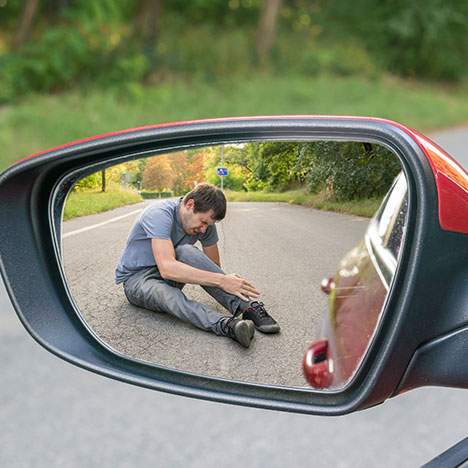When walking across busy streets, pedestrians’ attention to cars naturally increases. However, attention spans sometimes lapse and guards are let down — even if only for a split second — and a collision happens. As a pedestrian, maybe the only feeling worse than getting hit by a car is watching that car drive away from the scene before you can get the driver’s information. Quickly, your mind races to, “Can I sue a hit and run driver?”
Pedestrian Accident Injuries
According to the National Highway Traffic Safety Administration (NHTSA), there were 5,977 pedestrian fatalities in the United States in 2017 — that’s an average of one every 88 minutes. That number increased to 6,205 in 2019 or one every 85 minutes.
The 5,977 fatalities in 2017 accounted for 16% of the total number of fatalities in traffic collisions that year. The NHTSA also found that more pedestrian fatalities occurred in urban areas (80%) than in rural areas (20%). They also found a large majority of fatalities occurred at night (75%) compared to daytime (21%), dusk (2%) and dawn (2%).
The NHTSA also found that most pedestrian fatalities did not occur at intersections — 73%, compared to 18% at intersections. The remaining 9% occurred at various other locations like: roadsides/shoulders, parking lanes/zones, bicycle lanes, sidewalks, medians/crossing islands, driveway accesses, shared-use paths/trails, non-traffic way areas and other sites.
Do Pedestrians Have the Right of Way When Jaywalking?
Not necessarily. Like motorists, pedestrians are expected to follow the rules of the road. Under Section 21950 of the California Vehicle Code, drivers are to yield the right-of-way to pedestrians crossing at a marked crosswalk or within an unmarked crosswalk at an intersection.
But pedestrians must also obey traffic signals and signage where applicable. It’s against the law for a pedestrian to jaywalk or walk on areas of the road where pedestrian traffic is not allowed. Pedestrians also have a duty of care to not leave a curb or safe zone and walk into the path of oncoming vehicles.
Suing Someone for a Hit and Run

In California, collisions that involve an injury to a person other than the driver is covered under Section 20001 of the Vehicle Code. Under this law, the driver must immediately stop at the scene of the accident and:
- Provide their information (i.e., name, address, registration number) to the person struck, the drivers or occupants of other vehicles involved and police officers.
- Give reasonable assistance to any person injured in the accident, including transportation to a medical treatment facility.
- Produce their driver’s license if asked.
- Report the collision to the nearest police office if a person involved in the accident dies.
Failure to follow these rules may result in a penalty of up to four years in state prison and a $10,000 fine.
While the Vehicle Code deals with criminal proceedings, the injured person in a collision may retain a lawyer and sue the driver for both monetary and non-monetary damages. These could include medical bills, rehabilitation costs and home care expenses, as well as compensation for mental anguish and ongoing physical pain due to disfigurement.
If police are able to catch a driver who didn’t remain at the scene of a pedestrian accident, you may be able to file a lawsuit for any of these reasons. California law gives victims up to two years after the collision for suing a hit and run driver. With more security cameras around, as well as cameras in cellphones, the chances of police arresting a hit and run driver are higher today than ever before. If you’re the victim of a hit and run, you may want to speak to a pedestrian injury lawyer to sort out all your options and rights.
How Many Points is an At Fault Accident in California?
If it’s determined you’re at fault for a vehicle collision in California, that means you’ve been found to have been negligent or to have caused the accident and you’re liable for compensating other drivers involved for damages and medical bills. This also means the Department of Motor Vehicles (DMV) may apply negligent operator points to your license:
- One point may be applied for any conviction “involving the safe operation of a motor vehicle upon the highway.” This includes speeding and operating a vehicle that is mechanically unsafe to drive. Mechanical violations, such as not having an operational license plate light, may be assigned either 0 points or 1 point.
- Two points may be assigned for hit-and-run and driving under the influence. More points are given for these offences because they pose an increased traffic safety risk.
If you accrue too many points over a certain period of time, the DMV may impose penalties up to and including license suspension.
We’re Here to Help With Your Hit and Run Lawsuit
If you’re still wondering, “can I sue a hit and run driver,” Avrek Law is here to help you understand your legal options if you need a pedestrian injury attorney. The consultation is free, and you’ll get expert advice from a law firm with more than $1 billion recovered in over 45,000 cases. View one of our locations and contact Avrek Law for a free consultation. We want to hear more about your hit and run case!
